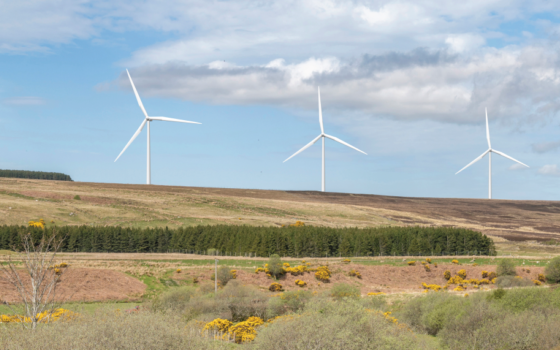28th November 2022
The Section 36 application for the Kirkton Energy Park has been submitted to the Scottish Government Energy Consents Unit.
Proposals for an energy park consisting of eleven wind turbines with a blade tip height of 149.9m and battery storage have been submitted to the Scottish Ministers for consent under Section 36 of the Electricity Act 1989.
Located across two working farms in Sutherland, approximately 2.1km to the south of Melvich, the eleven proposed turbines would have a total installed capacity of around 53MW, and would be supplemented by up to 20MW of battery storage. If consented, the energy park would have the potential to generate approximately 184,000 megawatt hours (MWh) of renewable electricity annually, sufficient to meet the needs of around 49,000 average UK households[1]. This equates to an annual reduction in CO2 emissions of approximately 80,000 tonnes per year[2], when compared to the amount of CO2 emitted by fossil fuels to produce the same amount of electricity. The proposed energy park would export the generation of renewable electricity to the grid via a connection agreement which the project has secured with the network operator, National Grid ESO, with a connection point at the Connagill 275/132kV substation.
As part of the planning process, a full Environmental Impact Assessment (EIA) has been conducted, which has examined the potential impacts of the proposed development on landscape, wild land, ornithology, ecology, as well as a number of other receptors. Wind2 have consulted the local communities throughout the development of the project in advance of the application submission, holding public exhibition events in 2021 and 2022, as well as meeting with community councils and other community groups, to convey information on the proposals and receive feedback from those who live in proximity to the project.
In addition to making a meaningful contribution towards meeting the renewable energy generation targets set out by the Scottish Government, such as the goal for Scotland to have a fully decarbonised energy system by 2045, there are a number of other, more localised, benefits which would be delivered by the Kirkton Energy Park. The project would provide an annual Community Benefit Fund, the value of which would be based on the rate recommended by the Scottish Government at the time of commissioning the proposed energy park. At present this rate is £5,000 per MW of installed capacity, and on this basis the Community Benefit Fund would have a value of c.£260,000 per annum.
As part of the Community Benefit Fund, a ‘near neighbour electricity contribution scheme’ will be offered for residents living nearby to the project, to allow a portion of the fund to be put towards residents’ electricity costs. Two potential options for the scheme have been proposed – Option 1, an electricity contribution scheme whereby residents in proximity of the turbines would receive a £400 annual contribution towards their home electricity bill for the lifetime of the project, and Option 2, a home energy efficiency grant where residents of properties could capitalise the electricity bill contribution, converting this to a single lump sum of £4,500 to fund or part fund measures to improve the energy efficiency and decarbonisation of their home.
In addition to the ‘near neighbour electricity contribution scheme’, the Kirkton Energy Park is proposed to become part of the Octopus Fan Club initiative, whereby households in proximity to the Kirkton Energy Park will have the option to opt in to either the near neighbour scheme or The Octopus Energy Fan Club programme, whereby they would receive a discount of up to 50% on the unit price of the electricity they use while the Kirkton Energy Park turbines are generating. The precise area around Kirkton which will be encompassed by the Fan Club will be the subject of consultation with the local communities.
An opportunity for community shared ownership is being offered as part of the Kirkton Energy Park proposals. This would offer local communities the ability to invest in, and acquire up to a 10% share of the project. The local communities would see a return on investment through profits produced throughout the lifetime of the project. Discussions are in progress with the Farr North Community Trust and other representative community groups in Sutherland. A memorandum of understanding (MoU) is being developed to set out the proposed terms for the shared ownership opportunity. Local Energy Scotland has been providing independent advice and support to communities interested in the shared ownership opportunity.
The application documents, including the environmental impact assessment (EIA) report, can be viewed on 'Project Info' page of the website or at www.energyconsents.scot (file reference number ECU00003244). Hard copies of the documents are available for public inspection in person, free of charge at the Highland Council Wick Office and the Thurso Library, during the opening hours of those facilities. A hard copy is also available at the Halladale Inn until 16th December, when the Inn closes for the season.
The S36 application will be advertised in the local press (the Northern Times) and national press (the Scotsman) in early December 2022. The public consultation period, during which members of the public can submit comments, will run until 27th January 2023. Any representations to the application may be submitted via the Scottish Government Energy Consents Unit website at www.energyconsents.scot/Register.aspx; by email to the Energy Consents Unit mailbox at representations@gov.scot; or by post to the Scottish Government, Energy Consents Unit, 4th Floor, 5 Atlantic Quay, 150 Broomielaw, Glasgow, G2 8LU, identifying the proposal and specifying the grounds for representation.
[1] Calculated using the most recent statistics from the Department of Business, Energy and Industrial Strategy (BEIS) showing that annual UK average domestic household consumption in 2020 was 3,748kWh
[2] Calculated using the most recent emission statistics from the Department of Business, Energy and Industrial Strategy (BEIS) supplied in the ‘Digest of UK Energy Statistics (July 2022) Table 5.14’
